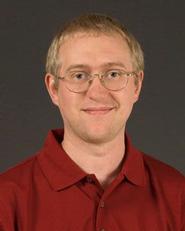
Assistant Professor of Chemistry Adam Van Wynsberghe was a contributing author of a paper published in the June issue of the journal Chemical Biology and Drug Design. The paper, titled “Applying Molecular Dynamics Simulations to Identify Rarely Sampled Ligand bound Conformational States of Undecaprenyl Pyrophosphate Synthase, an Antibacterial Target,” presents the results of research conducted in collaboration with researchers at the University of California-San Diego, the Howard Hughes Medical Institute and the University of Illinois at Urbana-Champaign.
The authors used molecular dynamics and docking studies to explore the conformational flexibility and drug-binding properties of a bacterial protein used in cell-wall synthesis, Undecaprenyl Pyrophosphate Synthase (UPPS). Since human cells do not contain cell walls, UPPS is an attractive target for antimicrobial drugs. The work described in the paper provides evidence that when designing inhibitors, multiple conformations of the protein target must be considered. The simulations reproduced, on average, the experimental volume of the binding pocket when no inhibitor was bound. However, the conformation that permitted strong binding of small molecule inhibitors had a much larger binding pocket volume and was only rarely sampled. This suggests that identifying these rare active conformations is essential to effective rational drug design.
The paper was cited by the Faculty of 1000 (F1000) service as a “must-read.” F1000 is a post-publication peer review service that identifies important articles in biomedical research and recommends them to their users. F1000 reviews approximately 1,500 articles each month, representing the top 2% of all articles published across 40 areas of biology and medicine.
Van Wynsberghe’s lab studies protein flexibility and dynamics using a variety of computational and theoretical techniques. The lab’s general goals are to develop and utilize molecular simulation methods to investigate biological and biochemical systems from a physical and chemical perspective.
Posted May 26, 2011
